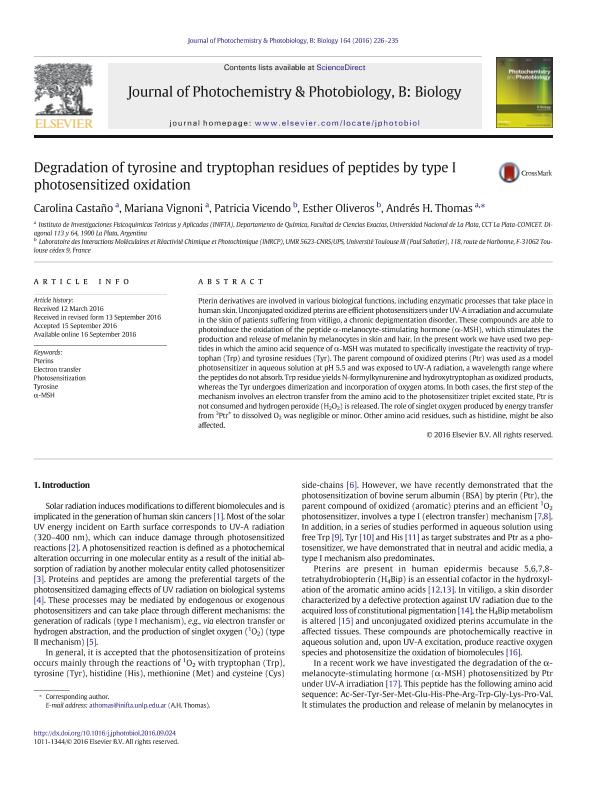Artículo
Degradation of tyrosine and tryptophan residues of peptides by type I photosensitized oxidation
Castaño Espinal, Diana Carolina ; Vignoni, Mariana
; Vignoni, Mariana ; Vicendo, Patricia; Oliveros, Esther; Thomas, Andrés Héctor
; Vicendo, Patricia; Oliveros, Esther; Thomas, Andrés Héctor
 ; Vignoni, Mariana
; Vignoni, Mariana ; Vicendo, Patricia; Oliveros, Esther; Thomas, Andrés Héctor
; Vicendo, Patricia; Oliveros, Esther; Thomas, Andrés Héctor
Fecha de publicación:
11/2016
Editorial:
Elsevier Science Sa
Revista:
Journal of Photochemistry and Photobiology B: Biology
ISSN:
1011-1344
Idioma:
Inglés
Tipo de recurso:
Artículo publicado
Clasificación temática:
Resumen
Pterin derivatives are involved in various biological functions, including enzymatic processes that take place in human skin. Unconjugated oxidized pterins are efficient photosensitizers under UV-A irradiation and accumulate in the skin of patients suffering from vitiligo, a chronic depigmentation disorder. These compounds are able to photoinduce the oxidation of the peptide α-melanocyte-stimulating hormone (α-MSH), which stimulates the production and release of melanin by melanocytes in skin and hair. In the present work we have used two peptides in which the amino acid sequence of α-MSH was mutated to specifically investigate the reactivity of tryptophan (Trp) and tyrosine residues (Tyr). The parent compound of oxidized pterins (Ptr) was used as a model photosensitizer in aqueous solution at pH 5.5 and was exposed to UV-A radiation, a wavelength range where the peptides do not absorb. Trp residue yields N-formylkynurenine and hydroxytryptophan as oxidized products, whereas the Tyr undergoes dimerization and incorporation of oxygen atoms. In both cases, the first step of the mechanism involves an electron transfer from the amino acid to the photosensitizer triplet excited state, Ptr is not consumed and hydrogen peroxide (H2O2) is released. The role of singlet oxygen produced by energy transfer from 3Ptr⁎ to dissolved O2 was negligible or minor. Other amino acid residues, such as histidine, might be also affected.
Palabras clave:
Electron Transfer
,
Photosensitization
,
Pterins
,
Tyrosine
,
Α-Msh
Archivos asociados
Licencia
Identificadores
Colecciones
Articulos(INIFTA)
Articulos de INST.DE INV.FISICOQUIMICAS TEORICAS Y APLIC.
Articulos de INST.DE INV.FISICOQUIMICAS TEORICAS Y APLIC.
Citación
Castaño Espinal, Diana Carolina; Vignoni, Mariana; Vicendo, Patricia; Oliveros, Esther; Thomas, Andrés Héctor; Degradation of tyrosine and tryptophan residues of peptides by type I photosensitized oxidation; Elsevier Science Sa; Journal of Photochemistry and Photobiology B: Biology; 164; 11-2016; 226-235
Compartir
Altmétricas



